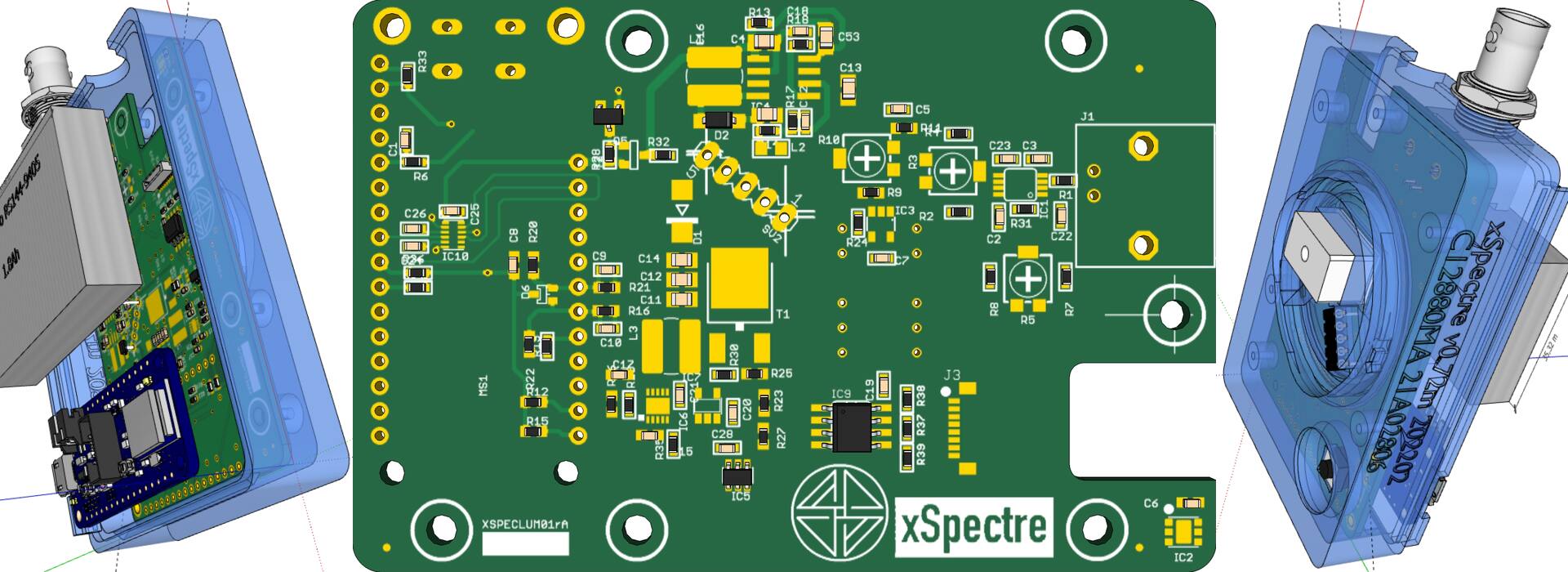

The technology of xSpectre's handheld spectrometer+ builds on the general developments within information and sensing technology. New miniaturized spectral sensors and probes for the concentration of different ions and physical properties have paved the way for our pocket sized soil laboratory.
Open-source initiatives within science has opened an avenue of modeling possibilities with the data and methods now available for free. The combination of open-source modeling tools and Artificial Intelligence (AI) with newly released global datasets on soil spectra is an important foundation for xSpectre's innovative solution.
Near Infra Red (NIR) spectroscopy is today's leading analysis method for rapid quality analysis of e.g. grain and roughage and to some extent also laboratory soil analyzes. With NIR spectroscopy it is possible to easily and quickly make both qualitative and quantitative measurements. The need for sample preparation is small and the measurement itself only takes a few seconds. While the method has entered laboratories, it is not widely spread as a field instrument, also because of the high prizes of the present generation of field-tuned spectrometers.
NIR includes electromagnetic radiation within the wavelengths ~700 and ~2500 nano meters (nm). For soil analysis a wide beam light source illuminates the sample and the reflected light is sensed, a method called diffuse NIR spectroscopy. The NIR radiation has a fairly low energy content, which means that no protective equipment or dilution is required. Another advantage of NIR is that the sample is not affected by the measurement and can thus be saved for more measurements.
The spectrum a NIR measurement generates is due to different molecules being able to absorb certain, and only certain, energy (wavelengths). The wavelengths absorbed depends on the kinds of molecules and bonds represented in a sample. Because the light is scattered when it is reflected and everything that is not absorbed thus does not reach the measuring probe (diffuse reflectance), it is not clear that the absorbance, i.e. the inverted reflectance, is directly proportional to a concentration. The absorption peaks therefore become unclear and overlapping and it is not possible to read a concentration directly from a spectrum.
Calibration is thus an important step in NIR analysis. The number of samples needed depends on what is being analyzed and the variation in the data material. Through statistical calculations revealing how analytical values correlate with the reflectance spectrum, a model for predicting unknown samples can be created.
The interpretation of a spectral signal requires a-priori knowledge on the typical spectral signal variation for the kind of sample that is analysed. Put differently, the translation from spectra to content requires a dedicated spectral library. The typical reference method for creating a spectral library for soils is to acquire both a spectra and perform a wet-chemistry laboratory analysis. Today, Machine Learning (ML), a branch of AI, is the favored method for defining spectral translation models. xSpectre has developed a mathematical-geometric modeling framework for facilitating the formulation, and improving the interpretability, of spectral models. The patent-pending method also uses AI, but confined to dimensions that allows users to interpret the results graphically.
In December 2021 the Open Soil Spectral Library, OSSL was launched. OSSL contains soil spectra and laboratory results from around the world and allows the construction of both global and regional translation models from spectra to various soil properties. But not all the world's geographical regions are covered in OSSL. And as soil conditions can vary quite a lot within short distances, it is a great advantage to use local data for creating the translation models.
xSpectre's spectrometer+ is equipped with external ports that allows direct sensing of key soil properties. Hence the spectrometer+, preferably with OSSL as a foundation, can be used for creating local translation models without the need for costly wet-chemistry laboratory analysis. This translation is greatly facilitated by the patent pending mathematical-geometric modeling framework, even allowing individual farmers to develop there own farm adjusted models.
Spectral sensors
Over the past decade the developments of spectral sensors has closely reflected (!) the developments in computer chips; they have become smaller, cheaper and more efficient. xSpectre's spectrometers, that typically cover the visible (VIS, 400-700 nm) and short wave NIR (700-1100 nm) wavelengths, are built using miniature spectral sensors from Hamamatsu and AMS. New technological developments (summarized in the article Miniaturization of optical spectrometers, by Yang et al and published in the journal Science 2021) is paving the way for miniaturized sensors also at longer wavelength.
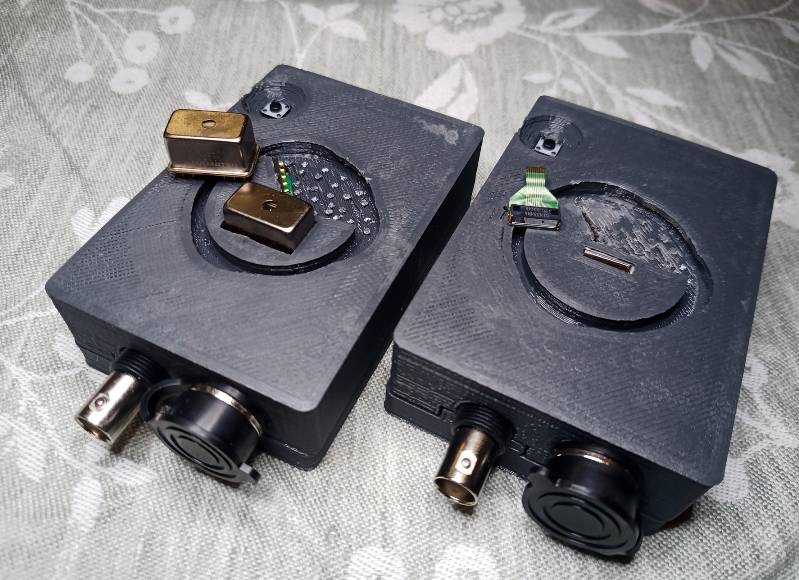 xSpectrolum+ v080 can be fitted with two alternative Hamamatsu spectral sensors; left: C12880MA/C12880MA for visible light, and right: C1348ma-01 for near infra-red light.
xSpectrolum+ v080 can be fitted with two alternative Hamamatsu spectral sensors; left: C12880MA/C12880MA for visible light, and right: C1348ma-01 for near infra-red light.
The latest version of xSpectre's handheld spectrometer, xSpectrolum+ v080, can be equipped for etiher capturing VIS (350-850 nm) or NIR (640-1050 nm) spectra. The next generation is deisnged to also include the spectral regions 1350-2150 nm using Hamamatsu single cell MEMS-FPI spectrum sensor with a tunable filter. (Note that to cover the full wavelength region demands three individual sensor of the present generation: 1350-1650nm, 1150-1850nm and 1750-2150nm).
Field probes
For direct, in-situ field measurements xSpectre's xSpectrolum+ has a sturdy aviation (GX16) plug that can use direct field sensing probes for:
The temperature, humidity, EC and salinity probes have a high (scientific) precision while the pH and NPK sensors are more indicative and are better used for relative content within the same soil region. These field probes are built with stainless steel pins that can be pushed into the soil without any further tool requirements.
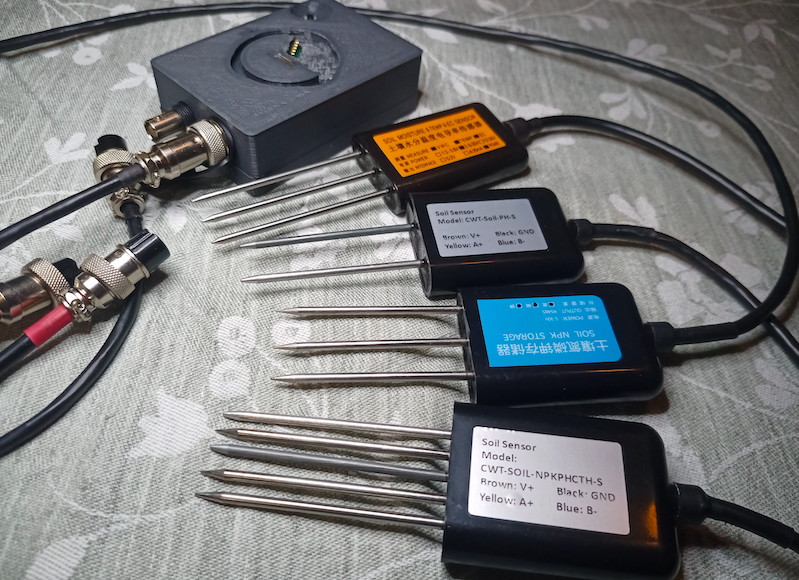 Field probes for soil properties that can be operated with xSpectrolum+. The frontmost probe can sense all the parameters of the other three combined (NPK, pH, temperature, soil moisture, electric conductivity and salinity).
Field probes for soil properties that can be operated with xSpectrolum+. The frontmost probe can sense all the parameters of the other three combined (NPK, pH, temperature, soil moisture, electric conductivity and salinity).
Laboratory Ion Selective Electrodes (ISE)
For laboratory soil sensing, xSpectre's xSpectrolum+ is equipped with a standard BNC connection for attaching Ion Selective Electrodes (ISEs). ISE is an analytical technique for determining the activity (concentration) of ions in aqueous solution by measuring relative electrical potential. The primary ions that can be monitored with xSpectre's spectrometer+ include:
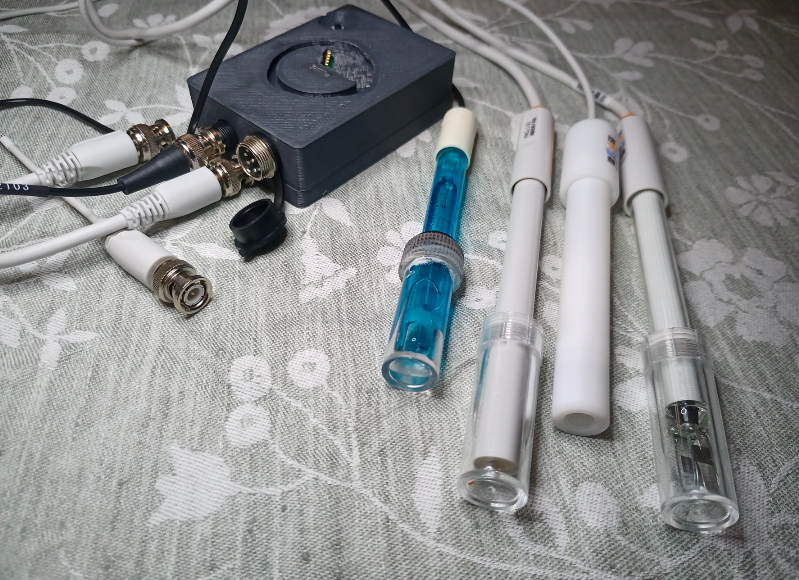 Ion Seletive Electrodes that can be used with xSpectrolum+; from left to rigth: pH, NO3-, NH4+ and electric conductivity.
Ion Seletive Electrodes that can be used with xSpectrolum+; from left to rigth: pH, NO3-, NH4+ and electric conductivity.
The past decade has seen a very rapid development in microcontrollers, both the hardware and the programming languages. This development has been led by Arduino and the C/C++ dialect they have developed. The de-factor standard that has developed has led to unified protocols and communication norms, allowing the microcontrollers to connect both to mobiles, tablets and computers on the one hand, and to the new generation of sensors listed above on the other.
xSpectre's spectrometer+ uses a microcontroller from Nordic Semiconductor and the Arduino C/C++ dialect for internal control functions, with commands and results sent either via USB-cable of Bluetooth Low Energy (BLE).
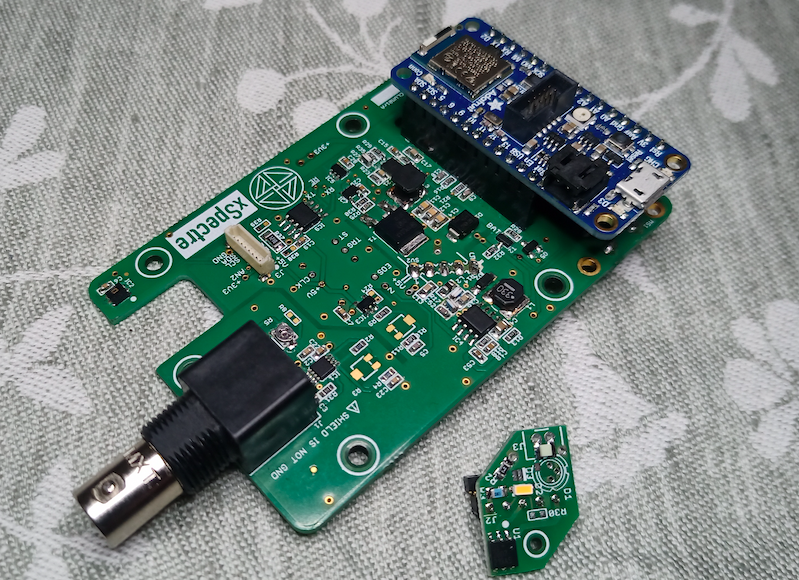 Figure 3. xSpectrolum+ v080 is built on a customized PCB (speclum) with light sources attached via a smaller (ledlum) PCB; Adafruit Feather nRF52840 express is used as microcontroller.
Figure 3. xSpectrolum+ v080 is built on a customized PCB (speclum) with light sources attached via a smaller (ledlum) PCB; Adafruit Feather nRF52840 express is used as microcontroller.
The spectrometer+ is operated by a cross-platform application (app) developed with Progressive Web Apps (PWA). In a nutshell PWA is a web-page that appears as an app and can be run on any browser (mobile, tablet or computer).
Through the app the user controls the spectrometer+ and the device that hosts the app (i.e. the mobile) is used as an Information and Communication Technology (ICT) center that links the spectrometer+ to xSpectre's backend server solution.
New developments in cloud services (e.g. Google Could Run) are improving the deployment of many internet solutions, including PWA; the novel services make it easier to administer internet resources, support automation for seamless integration of different services and offer leaner hosting that is charged only when used. xSpectre is hence at present (January 2023) shifting from an older deployment system to using Google Cloud Run.
One of the innovative parts of xSpectre's solution is the patent pending mathematical-geometric modeling framework. The framework serves two main purposes; the first is to facilitate for domain experts (farmers and ag-tech specialists regarding soil conditions) to construct spectral translation models; the second to graphically present results of spectral scans, including contents, quantities, correlations and uncertainties.
The Swedish patent application is being finalized as this is written. The international, PCT, application was published 26 July 2022: SE2150075 - A method and software product for providing a geometric abundance index of a target feature for spectral data.
The mathematical-geometric modeling framework predicts soil properties on par with ML models, also because it is a hybrid-method that employs ML for calibration. The primary advantage with the mathematical-geometric modeling framework is thus not the statistical performance as such, but the vast improvement in intelligibility allowing non-AI/ML experts to develop and interpret spectral models.